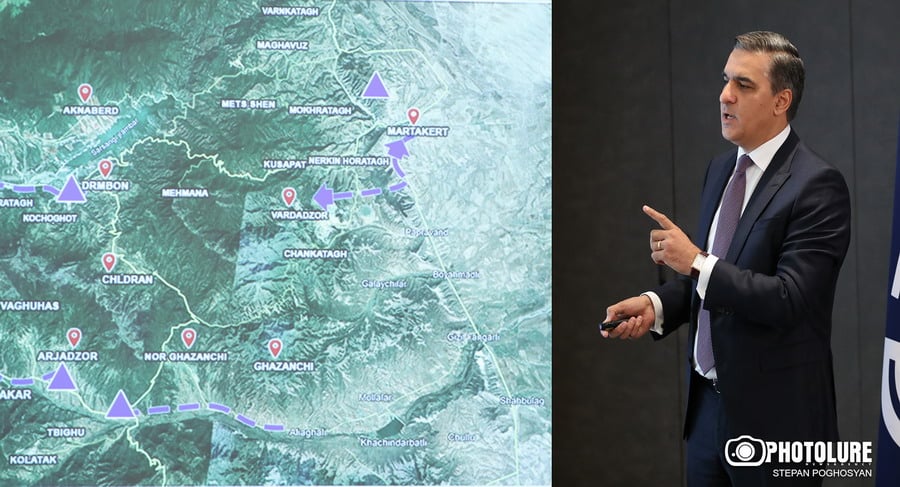Director of the Center for Law and Justice “Tatoyan” Foundation, former Ombudsman Arman Tatoyan presented exclusive facts about the armed attacks and advances displacements by Azerbaijan on September 19.
The fact-finding work was carried out immediately after the armed attack, and these facts confirm the connection between the state policy of Azerbaijan and the disaster. “Azerbaijani authorities have thoroughly prepared for these armed attacks. We have identified their strategic goals and directions through facts.
One of the goals of the armed services of Azerbaijan, and of course also the authorities, is to cut off civilian settlements. At that time, we had four civilian settlements in Artsakh: Martakert, Askeran, Martuni, and Stepanakert. At the beginning of the armed attacks, they did it in such a way as to isolate the people of the civilian settlements and, at the same time, continue to bombard the civilians; they forced, for example, in Martakert, as if you brought people into a large room, the exit was only one door, and with constant armed attacks, they forced people to go to this place and that corner.
Read also
They also closed the door, taking their positions. In addition, they also cut the connection between our military and civilian settlements. That was, in fact, one of the steps of strategic significance for them. After the 44-day war, most of our soldiers were residents of villages and family members, and of course, operational contact was maintained with civilian settlements; people were able to understand whether there were advances of the Azerbaijani armed forces or not. Azerbaijani armed service members have solved this issue, that’s why in Martakert, Askeran area, people were surprised in many places. In the villages near the Sarsang reservoir, people even had to go out without clothes and shoes; they didn’t have time to prepare.”
The Azerbaijani armed attack started at noon. That is when the children were at school, doing lessons, and the students of the Artsakh State University were at the university. During the siege, parents often took their children to school and went to Stepanakert or another place to find food. That was why families could not find each other during armed attacks; they were separated, mothers did not know where their children were, and children did not know where their parents were. It was not accidental either; according to Tatoyan, it was Azerbaijan’s intended, pre-planned policy that created a panic and chaotic situation.
Arman Tatoyan showed the directions of Azerbaijan’s attack on the map, pointing out important facts. “They have concentrated their forces on individual settlements; they have done it specifically to isolate them, to cut off communication. Martakert was attacked from 4 directions at the same time. The first is the direction of Dadivank; they closed the roads they made people leave that settlement. Then, Charektar, Getavan, to Drmbon. The next direction was the one going to Vardadzor; another sub-branch was in the direction of Martakert city. Next, they moved toward Nareshtar, aiming to reach the Khachen Bridge. They also had forces in the area of the Khachen Bridge; they appeared at once and closed it. They pursued two strategic goals.”
Tatoyan showed with arrows on the map how people had to flee from one settlement to another to save them. “Azerbaijan announced the capture of our 71-year-old compatriot. He was in Getavan. The Azerbaijani side declares that there were no ethnic cleansings; they state rudely and cynically that people left of their own free will. How did people come out of their own free will? We collected data in the settlements that those a little late in coming out were captured, injured, and killed. They did it on purpose.
For example, in Getavan, we have a case of capture and a confirmed case of killing a civilian. A part of Getavan went to Haterk; a part stayed in Getavan. The part that remained then proceeded to Drmbon. From Haterk, they went down Aknaber toward the Sarsang Reservoir to Drmbon again because Azerbaijani armed attacks surrounded them. The Khacheni Bridge, like the Hakari Bridge, was closed in all directions; people had nowhere to go.” Tatoyan mentioned that Martakert suffered a lot from the armed attack because people had half an hour or an hour; they even had to leave the settlements barefoot.
Tatoyan told a story: the man went to help his relatives and saw that they had already killed them; he secretly tried to get out of there with his friend in his car but naively stuck to the signal. The armed service members of Azerbaijan found out about it and started firing in the direction of that car. The man was able to get away, however. The pictures of the vehicle are there as fact. It proves that voluntary withdrawal is a fairy tale.
Hripsime JEBEJYAN























































